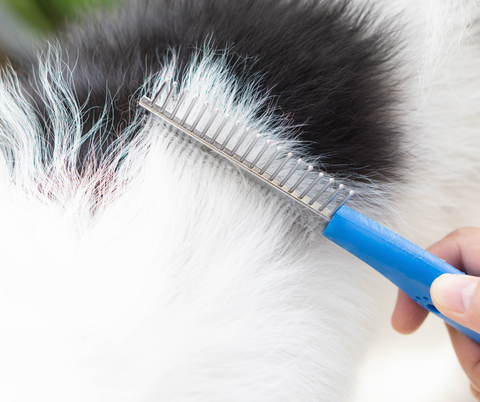Lyme disease doesn’t just affect humans. Approximately 10% to 60% of dogs test positive for Lyme infections.
The chronic disorder is transmitted to canines when a tick carrying Borrelia Burgdorferi bacteria bites the skin. These ticks are commonly known as deer ticks, and they are found in fifteen US states, most of which are in the Northeast.
How can you prevent tick bites on dogs? And what should you do if your dog tests positive for Lyme disease? We have answered your tick-related questions below. Let’s explore.
How Does Lyme Disease Affect Dogs?
Lyme disease is the most common illness in dogs. Symptoms of Lyme disease in dogs include:
- Loss of appetite
- Swollen or painful joints
- Fever
- Fluctuating lameness
- Lethargy
- Swollen lymph nodes
- Gastrointestinal problems
Symptoms can range from mild to severe, and many dogs carry Lyme disease without showing signs. The infection spreads through the joints, heart, and central nervous system. If left untreated, Lyme disease can make its way to the kidneys (which can be fatal) or cause canine arthritis.
Managing Lyme Disease in Dogs
Lyme disease is manageable when detected early. Various treatment methods help manage symptoms, help with discomfort, and slow the disease from reaching the kidneys.
Veterinarians treat Lyme disease using antibiotics like doxycycline, amoxicillin, and azithromycin. Dogs take the antibiotics for about four weeks. If the infection recurs or the dog suffers another tick bite, a vet will administer another round.
If your dog is struggling with joint problems (which is one of the more common symptoms of a tick bite in dogs), natural joint supplements may help with discomfort and support a normal inflammatory response. Look for products that include turmeric, antioxidants, and hemp.
Preventing Tick Bites on Dogs
Lyme disease in dogs is preventable if dog owners take the right steps. Pet owners who know how to avoid, repel and spot ticks can keep their fur babies safe from tick-borne diseases.
Know When Ticks Are a Threat
Tick season begins when warm spring weather starts. Ticks disappear once temperatures start to drop, usually mid-to-late fall. Ticks are not a threat during cold winter months.
Steer Clear of Tick Habitats
Educate yourself on where ticks are most likely to live. Then keep your dog far away from those habitats.
Most deer ticks reside in tall grasses and thick brushes. They are often found near wet marshes or in the woods. The ticks sit on branches, stems, or leaves and wait for a host (like your dog) to walk through. The tick latches onto the dog and attaches to its skin. Once on a dog, deer ticks can transmit Lyme disease within 24 to 48 hours.
When outside, make sure your dog avoids tall grasses and wandering through the woods. Maintain a close eye on your dog or keep Fido leashed to prevent ticks from latching onto his fur.
Conduct Regular Tick Checks
During tick season, perform tick checks after your dog has been outside. The most common places for ticks to hide on dogs include:
- Around the ears (especially inside or behind them)
- Under the tail
- In the genital region
- Near the eyelids
- Beneath the collar
- Around the legs
Run a brush or your fingers through your dog’s fur. Stop if you feel any small bumps. Keep a magnifying glass and tweezers nearby to quickly grab any ticks. Flush ticks down the toilet to prevent them from finding a new host.

Repel Ticks
While many ticks are drawn to canines, there are certain smells that prevent a tick from latching onto your pup. These odors include:
- Lavender
- Lemongrass
- Peppermint
- Rosemary
- Cedar
- Rosemary
- Eucalyptus oil
Purchase essential oils with these smells. Sprinkle a few drops onto your dog’s collar before you let him roam outside. Or you can dilute the oil with water to create a natural tick repellent. Gently spray your dog’s coat every morning, and ticks won’t want to go near your pooch.
What If I Found a Tick Bite on My Dog?
Tick bites resemble mosquito bites. They are small, red bumps on the skin. Deer tick bites have a bright red color with red rings around the center, similar to a bullseye.
If you find a tick bite on your dog, first check to see if the tick is nearby. If so, carefully remove it with tweezers and flush the tick down the toilet. Use a damp paper towel or cloth to gently dab the tick bite. Apply alcohol to clean the wound. Apply a pea-sized amount of dog-friendly topical antibiotic cream to the bite.
Over the next few days, continue checking the bite. The skin should heal within one to two days. If the infection gets worse or your dog shows symptoms of dog tick diseases, contact your veterinarian immediately.
Turmeric: The Natural Dog Lyme Defense
Tick bites on dogs are common, especially during the spring and summer. While ticks can cause severe issues, like canine Lyme disease, pet owners can take action to protect their pups and keep their furry friends healthy.
Turmeric supplements may be a great option as turmeric may help support normal a inflammatory response and contains antioxidant compounds to support healthy joints in dogs.













